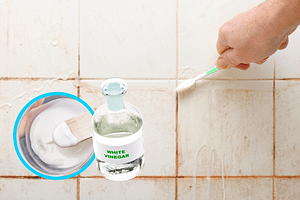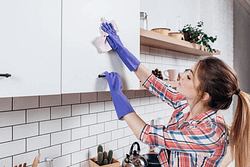Welcome to our comprehensive guide on using white vinegar as a powerful and eco-friendly cleaning agent!
White vinegar is a versatile household staple that can be used for a wide range of cleaning tasks.
In this blog post, we will explore the many benefits of white vinegar and provide you with practical tips and tricks to effectively clean various areas of your home using this natural solution.
What is White Vinegar?
White vinegar, also known as distilled vinegar, is a clear liquid made from the fermentation of ethanol.
It is a popular ingredient in cooking, but its acidity and antibacterial properties also make it an excellent cleaning agent.
White vinegar typically has an acidity level of around 5%, which makes it safe for most surfaces and materials.

Benefits of Cleaning with White Vinegar
Using white vinegar as a cleaning agent offers several advantages over conventional chemical cleaners.
Here are some key benefits:
- Environmentally friendly: Unlike many commercial cleaning products that contain harsh chemicals, white vinegar is non-toxic and biodegradable. It is a safer option for both your health and the environment.
- Cost-effective: White vinegar is incredibly affordable and readily available in most households. You can save money by using it as a multipurpose cleaner.
- Antibacterial properties: The acetic acid in white vinegar has antibacterial properties that can help kill germs and disinfect surfaces effectively.
- Deodorizing abilities: White vinegar is also great for neutralizing odors, making it a handy tool for eliminating unwanted smells from various areas of your home.
Cleaning Tips and Recipes with White Vinegar
Now, let's delve into some practical applications of white vinegar for cleaning different areas of your home:

1. Kitchen Cleaning
White vinegar is particularly useful in the kitchen due to its grease-cutting abilities and deodorizing properties.
Here's how you can use it to keep your kitchen sparkling clean:
- Unclog and deodorize the sink by pouring a cup of white vinegar down the drain followed by hot water.
- Remove mineral deposits from your coffee maker by running a mixture of equal parts white vinegar and water through a brewing cycle, followed by a cycle of plain water.
- Clean your microwave by heating a bowl of equal parts white vinegar and water for a few minutes. The steam will help loosen food splatters, making them easier to wipe away.

2. Bathroom Cleaning
The bathroom can be a challenging area to clean, but white vinegar can simplify the process.
Try these tips to achieve a fresh and germ-free bathroom:
- Remove soap scum and hard water stains from shower doors by spraying them with undiluted white vinegar. Let it sit for a few minutes before wiping clean.
- Clean and disinfect your toilet bowl by pouring one cup of white vinegar into the bowl. Let it sit for several hours (or overnight) before scrubbing with a toilet brush and flushing.
- Get rid of mildew and mold in the bathroom by spraying undiluted white vinegar onto affected areas. Leave it on for a few minutes, then scrub with a brush or sponge.

3. Laundry Room Tips
White vinegar can also be used to enhance your laundry routine and tackle common laundry problems.
Try the following tips:
- Eliminate odors from clothes by adding half a cup of white vinegar to the rinse cycle.
- Brighten whites by soaking them in a mixture of one part white vinegar and four parts water before washing as usual.
- Remove stubborn stains by applying undiluted white vinegar directly to the stain. Let it sit for a few minutes before laundering as normal.

4. General Household Cleaning
White vinegar is not limited to specific areas but can be used throughout your home for various cleaning tasks:
- Clean windows and glass surfaces by mixing equal parts white vinegar and water in a spray bottle. Spray the solution onto the surface and wipe with a microfiber cloth for streak-free results.
- Remove carpet stains by spraying them with a mixture of equal parts white vinegar and water. Blot the stain with a clean cloth until it lifts.
- Refresh and deodorize fabric upholstery by spritzing it with a solution of one part white vinegar and two parts water. Allow it to air dry.

Precautions and Limitations
While white vinegar is generally safe to use, there are a few precautions to keep in mind:
- Test first: Before using white vinegar on any surface, it's wise to test it in an inconspicuous area to ensure it doesn't cause any damage or discoloration.
- Avoid certain surfaces: Do not use white vinegar on porous materials like granite or marble, as the acid can etch or damage the surface.
- Dilute if necessary: While undiluted white vinegar is effective for tough stains or heavy-duty cleaning, you may need to dilute it with water for more delicate surfaces.
Additional cleaning tips you may find helpful:
Looking for recommendations for the cleaning supplies to get?
Continue reading on:
- 20 Best Cleaning Solution for Hardwood Floors
- 20 Best Cleaning Robots
- 20 Best Cleaning Gloves
- 30 Best Cleaning Laundry Detergents
- 30 Best Cleaning Solution for Laminate Floors
- 50 Best Cleaning Tools
- 50 Best Cleaning Supplies
- 59 Best Cleaning Products
- 20 Top Cleaning Gadgets for a Sparkling Home
- 21 Top Cleaning Tools for a Sparkling Home
- 10 Top Cleaning Products
Conclusion
White vinegar is an affordable, eco-friendly, and versatile cleaning solution that can effectively tackle various cleaning tasks around your home.
By incorporating these tips into your cleaning routine, you can enjoy a sparkling clean living space while minimizing your environmental impact.
Give white vinegar a try and experience the power of this natural cleaning agent!
